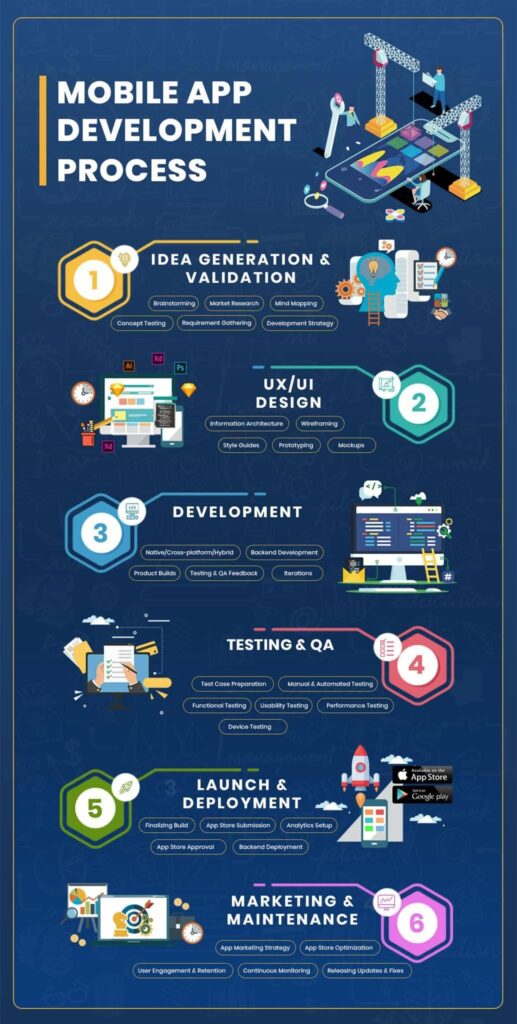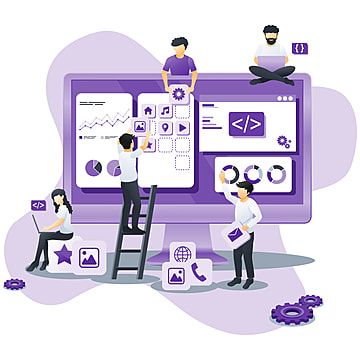Welcome to the comprehensive guide on mobile app development, where we will walk you through every step of turning your innovative idea into a fully functional and successful mobile application. Mobile apps have become an integral part of modern life, and creating one can be a rewarding experience. Whether you’re an entrepreneur, a business owner, or an aspiring developer, this guide will provide you with valuable insights, tips, and strategies to bring your app to life and make it a resounding success.
A Comprehensive Guide to Mobile App Development: From Idea to Launch
In this guide, we will cover everything you need to know to develop a mobile app from start to finish. Below is a detailed outline of the topics we’ll explore:
| Comprehensive Guide | Subheading |
|---|---|
| I. Understanding the Mobile App Development Landscape | A. Mobile App Market Trends |
| B. Exploring the Most Popular App Categories | |
| C. Analyzing the Target Audience | |
| D. Identifying Your Unique Selling Proposition (USP) | |
| II. Market Research and Idea Generation | A. Conducting Market Research |
| B. Brainstorming and Idea Generation | |
| C. Evaluating the Feasibility of Your App Idea | |
| III. Defining the App Features and Functionality | A. Determining Core Features |
| B. Creating a User Persona | |
| C. Wireframing and Prototyping | |
| IV. Choosing the Right Development Approach | A. Native App Development |
| B. Hybrid App Development | |
| C. Web App Development | |
| V. Selecting the Right Technology Stack | A. Front-End Technologies |
| B. Back-End Technologies | |
| C. Database Selection | |
| VI. Mobile App Design and User Experience | A. User-Centric Design Principles |
| B. Creating an Intuitive User Interface (UI) | |
| C. Incorporating UX Best Practices | |
| VII. Mobile App Development: Coding and Testing | A. Building the App Backend |
| B. Implementing Front-End Elements | |
| C. Rigorous Testing and Quality Assurance | |
| VIII. Security and Data Privacy in Mobile Apps | A. App Security Best Practices |
| B. Safeguarding User Data | |
| IX. Mobile App Monetization Strategies | A. In-App Purchases |
| B. Subscription Models | |
| C. Advertising Revenue | |
| X. App Store Optimization (ASO) and Marketing Strategy | A. Writing an Appealing App Description |
| B. Choosing the Right App Keywords | |
| C. Promotional Strategies for App Launch | |
| XI. Beta Testing and User Feedback | A. Conducting Beta Testing |
| B. Gathering and Analyzing User Feedback | |
| XII. Preparing for App Launch | A. Creating a Launch Plan |
| B. Setting App Launch Goals | |
| XIII. Launching Your Mobile App | A. Submitting to App Stores |
| B. Leveraging Social Media and Influencers | |
| XIV. Post-Launch Maintenance and Updates | A. Monitoring App Performance |
| B. Addressing Bugs and Issues | |
| XV. Measuring Success: App Analytics | A. Setting Key Performance Indicators (KPIs) |
| B. Utilizing Analytics Tools | |
| XVI. Scaling Your Mobile App | A. Analyzing User Growth |
| B. Expanding to New Markets | |
| XVII. Dealing with Challenges and Competition | A. Adapting to Market Changes |
| B. Staying Ahead of Competitors | |
| XVIII. Legal Considerations for Mobile App Development | A. Intellectual Property Rights |
| B. App Store Guidelines | |
| XIX. The Future of Mobile App Development | A. Emerging Technologies |
| B. Predictions and Trends |
A Comprehensive Guide to Mobile App Development: From Idea to Launch

Developing a mobile app can seem like a daunting task, but with proper planning and execution, it can also be an incredibly rewarding experience. So, let’s dive into the various stages of mobile app development:
Understanding the Mobile App Development Landscape
A. Mobile App Market Trends: The mobile app market is continuously evolving, with new trends and technologies shaping its landscape. Stay updated on the latest trends, such as augmented reality (AR) and artificial intelligence (AI), to identify potential areas for innovation in your app.
B. Exploring the Most Popular App Categories: Analyze the most popular app categories and consider which one aligns with your app idea. Some popular categories include social networking, gaming, e-commerce, health and fitness, and productivity.
C. Analyzing the Target Audience: Understand your target audience’s preferences, pain points, and behaviors. Conduct surveys, interviews, or use analytics tools to gather valuable data that will guide your app development decisions.
D. Identifying Your Unique Selling Proposition (USP): What sets your app apart from the competition? Define your unique selling proposition, which will be a key factor in attracting users to your app.
Market Research and Idea Generation
A. Conducting Market Research: Thoroughly research your target market to identify gaps and opportunities. Analyze competitors’ apps to learn from their successes and shortcomings.
B. Brainstorming and Idea Generation: Gather a team or work solo to brainstorm app ideas. Let your creativity flow and explore various possibilities before settling on the most promising one.
C. Evaluating the Feasibility of Your App Idea: Assess the technical, financial, and market feasibility of your app idea. Ensure that it aligns with your capabilities and resources.
Defining the App Features and Functionality
A. Determining Core Features: Identify the essential features your Mobile App Development must have to fulfill its purpose. Avoid feature bloat and focus on providing a seamless user experience.
B. Creating a User Persona: Develop a detailed user persona representing your ideal app user. Understanding your target user’s preferences will help tailor the app to their needs.
C. Wireframing and Prototyping: Create wireframes and prototypes to visualize the app’s layout and functionality. This step will facilitate design and development discussions.
Choosing the Right Development Approach
A. Native App Development: Developing a native app ensures optimal performance and access to device-specific features. Consider this approach for a high-performance app.
B. Hybrid App Development: Hybrid apps offer cross-platform compatibility, allowing you to build a single app that works on multiple platforms. This approach can save development time and costs but may have some trade-offs in terms of performance compared to native apps.
C. Web App Development: Web apps run on web browsers and are accessible across various devices. While they don’t require installation, they may have limitations in utilizing certain device features. Consider this approach if your app’s core functionality can be delivered through a web interface.
Selecting the Right Technology Stack
A. Front-End Technologies: Choose the front-end technologies that align with your app’s requirements and your development team’s expertise. Common technologies include HTML5, CSS, and JavaScript frameworks like React or Angular.
B. Back-End Technologies: Select the back-end technologies that will power your app’s server-side operations. Options include popular programming languages like Node.js, Python, Ruby, or PHP, along with corresponding frameworks and databases.
C. Database Selection: Decide on the database technology that suits your app’s data storage needs. Choices include relational databases (e.g., MySQL, PostgreSQL) and NoSQL databases (e.g., MongoDB, Firebase) based on your data structure and scalability requirements.
Mobile App Design and User Experience
A. User-Centric Design Principles: Prioritize user-centric design to create an intuitive and enjoyable user experience. Emphasize simplicity, clarity, and ease of navigation throughout the app.
B. Creating an Intuitive User Interface (UI): Design a visually appealing and user-friendly interface that reflects your app’s brand and resonates with your target audience. Incorporate elements like buttons, icons, and color schemes that enhance usability.
C. Incorporating UX Best Practices: Implement best practices in user experience design, such as reducing loading times, providing clear error messages, and ensuring accessibility for all users, including those with disabilities.
Mobile App Development Coding and Testing
A. Building the App Backend: Develop the app’s back-end logic and server-side functionalities. Ensure robust security measures are in place to protect user data and prevent unauthorized access.
B. Implementing Front-End Elements: Integrate the front-end design with the back-end functionalities, creating a seamless user experience. Regularly test the app on various devices to ensure compatibility.
C. Rigorous Testing and Quality Assurance: Thoroughly test the app for bugs, performance issues, and usability problems. Conduct both manual and automated testing to identify and resolve any issues before launch.
Security and Data Privacy in Mobile Apps
A. App Security Best Practices: Implement security measures such as encryption, secure authentication, and regular security audits to safeguard the app from potential cyber threats.
B. Safeguarding User Data: Respect user privacy by handling personal data responsibly. Clearly communicate your data collection and usage practices through a privacy policy.
Mobile App Monetization Strategies
A. In-App Purchases: Consider offering in-app purchases for premium features or virtual goods to generate revenue.
B. Subscription Models: Implement subscription plans that provide users with ongoing access to premium content or services for a recurring fee.
C. Advertising Revenue: Generate income through advertisements displayed within the app. Balance ad placements to avoid disrupting the user experience.
App Store Optimization (ASO) and Marketing Strategy
A. Writing an Appealing App Description: Craft a compelling app description that highlights its unique features and benefits. Use relevant keywords to improve discoverability in app store searches.
B. Choosing the Right App Keywords: Conduct keyword research to identify popular and relevant search terms users use to find apps similar to yours. Incorporate these keywords in your app’s metadata.
C. Promotional Strategies for App Launch: Plan a comprehensive marketing strategy to create buzz around your app’s launch. Leverage social media, influencer marketing, and content marketing to reach your target audience.
Beta Testing and User Feedback
A. Conducting Beta Testing: Invite a group of beta testers to try out your app and provide feedback. Use their insights to identify and fix any remaining issues.
B. Gathering and Analyzing User Feedback: Listen to user feedback and make necessary improvements to enhance the app’s user experience and functionality.
Preparing for App Launch

A. Creating a Launch Plan: Develop a detailed launch plan that outlines the steps leading up to the app’s release.
B. Setting App Launch Goals: Set realistic goals for the app’s performance and user acquisition during the initial launch phase.
Launching Your Mobile App
A. Submitting to App Stores: Follow the guidelines of app stores (e.g., Apple App Store, Google Play Store) to submit your app for review and approval.
B. Leveraging Social Media and Influencers: Harness the power of social media and influencers to create awareness about your app among potential users.
Post-Launch Maintenance and Updates
A. Monitoring App Performance: Regularly monitor app analytics to gain insights into user behavior and app performance.
B. Addressing Bugs and Issues: Promptly address any bugs or issues reported by users and release updates to improve the app’s stability and functionality.
Measuring Success: App Analytics
A. Setting Key Performance Indicators (KPIs): Define KPIs to track your app’s success and measure its performance against your goals.
B. Utilizing Analytics Tools: Use analytics tools to gather data on user engagement, retention rates, and revenue to make informed decisions.
Scaling Your Mobile App
A. Analyzing User Growth: Analyze user data to identify opportunities for scaling and expanding your user base.
B. Expanding to New Markets: Explore possibilities for introducing your app to new geographical regions and demographics.
Dealing with Challenges and Competition
A. Adapting to Market Changes: Stay agile and be prepared to adapt to market trends and changes.
B. Staying Ahead of Competitors: Monitor your competitors’ actions and strategies to maintain a competitive edge.
Legal Considerations for Mobile App Development
A. Intellectual Property Rights: Protect your app’s intellectual property through copyright, trademarks, or patents if applicable.
B. App Store Guidelines: Comply with the guidelines set by app stores to avoid potential rejection or removal of your app.
The Future of Mobile App Development
A. Emerging Technologies: Explore emerging technologies that may shape the future of mobile app development, such as AI, blockchain, and 5G.
B. Predictions and Trends: Stay informed about industry predictions and trends to anticipate future opportunities and challenges.
FAQs
Can I develop a mobile app without any coding experience?
Absolutely! You can use no-code or low-code app development platforms that require minimal coding knowledge to create functional apps. These platforms offer intuitive drag-and-drop interfaces, making app development accessible to individuals without extensive coding backgrounds.
How long does it take to develop a mobile app from idea to launch?
The time required for mobile app development varies based on the complexity of the app and the chosen development approach. It can take anywhere from several weeks to several months to complete the entire process. Careful planning, efficient development, and proper testing are essential to ensure a successful and timely launch.
Is it necessary to hire a mobile app development agency or team?
While it’s possible to develop an app independently or with a small team, hiring a dedicated mobile app development agency or team can offer several advantages. Professional developers bring expertise, experience, and a streamlined development process, resulting in a polished and high-quality app. Additionally, they can provide ongoing support and updates after the app’s launch.
How can I monetize my mobile app effectively?
There are various monetization strategies for mobile apps. In-app purchases allow users to buy premium features or virtual goods. Subscription models offer recurring revenue by providing access to exclusive content or services. Advertising revenue can be generated by displaying ads within the app. Consider the nature of your app, target audience, and competitors while choosing the most suitable monetization strategy.
What are the key elements to consider in app store optimization (ASO)?
App store optimization (ASO) is crucial for enhancing app visibility and increasing downloads. Key elements to focus on include choosing relevant and high-traffic keywords for your app’s title and description, using eye-catching and professional app icons and screenshots, and garnering positive user reviews and ratings. An appealing app description with clear and concise information about the app’s features and benefits also plays a vital role in ASO.
How can I gather user feedback and improve my app post-launch?
User feedback is essential for refining and improving your app post-launch. Implement in-app feedback mechanisms, encourage users to leave reviews, and create a dedicated support channel for users to report issues or suggest improvements. Regularly analyze user feedback and use it to prioritize updates and enhancements based on user needs and preferences.
Conclusion
Congratulations! You’ve now been equipped with a comprehensive guide to mobile app development, from generating a brilliant idea to successfully launching your app in the market. Remember that app development is a dynamic and iterative process. Stay open to learning, adapting, and improving your app based on user feedback and market trends.
Creating a successful mobile app requires a combination of technical skills, creativity, and a deep understanding of your target audience’s needs. With this guide and your determination, you have the tools to embark on an exciting journey of app development. Now, go forth and turn your app idea into a reality! Embrace challenges, celebrate achievements, and don’t forget to have fun throughout the development process.








6 thoughts on “A Comprehensive Guide to Mobile App Development: From Idea to Launch”